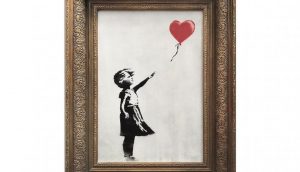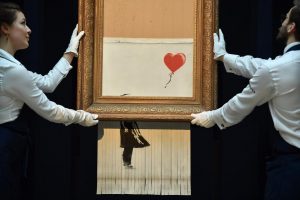Love is in the air? No, it’s in the shredder.
Oct 29, 2018
Art comes in many shapes and forms. And it comes in many different styles. But ultimately, art is a dialogue between the creator and the viewer. Sometimes that conversation comes in pieces.

A girl stands longing for her balloon that has just escaped from her grasp. Banksy’s original work “Girl with Balloon,” which was made a few years ago, was put up for auction on Oct. 5, 2018.
In early October, the famous England-based street artist, Banksy, shredded a piece of his artwork seconds after it was sold for 1.4 million U.S. dollars. The painting that was sold and shredded was a copy of Banksy’s original street work. Banksy created the first girl and red balloon street art in 2002 on a bridge in South Bank, London.
On the day of the sale, the elusive artist posted a video to his Instagram of him building a shredder into the frame of the work. The video described how he did it and included a caption that shed some light on why. The caption said, “The urge to destroy is also a creative urge.”
Banksy cited the famous Spanish painter, Pablo Picasso. But it was actually a quote originally from Mikhail Bakunin, a well-known Russian philosopher and a well-known atheist. Picasso stole the quote from Bakunin, and in doing so he held true to one of his own more famous statements: “Good artists copy, great artists steal.”

Banksy shredded his artwork, making the piece worth more than it was ever originally.The girl’s face cannot be seen but the red balloon still taunts her.
In a provocative example of life copying art copying life, Banksy technically stole and destroyed someone’s property, i.e., the person who bought and paid $1.4 million for his work of art had many fans and critics question whether Banksy went too far and committed fraud. They miss the point. His is more than just destroying someone’s property. His shredding of the artwork was itself one of Banksy’s newest works of art. He purposely destroyed the piece before the buyer claimed it, which arguably makes it more special. . . and more valuable.
People have different opinions on the shredding of the piece ― some like it, others don’t. But in the end, that is what art is supposed to do. Art embodies the artists’ thoughts and opinions. It provokes in the viewers’ various emotions, sometimes even passionate ones. Banksy used these emotions to his advantage in order to create a new controversial piece. He did this with the intention to provoke us, the viewers. Our reactions to what he did prove the point he wanted to make. That art can be anything. In the end, he changed our perspectives and, in turn, how we view art and, possibly, the world.





